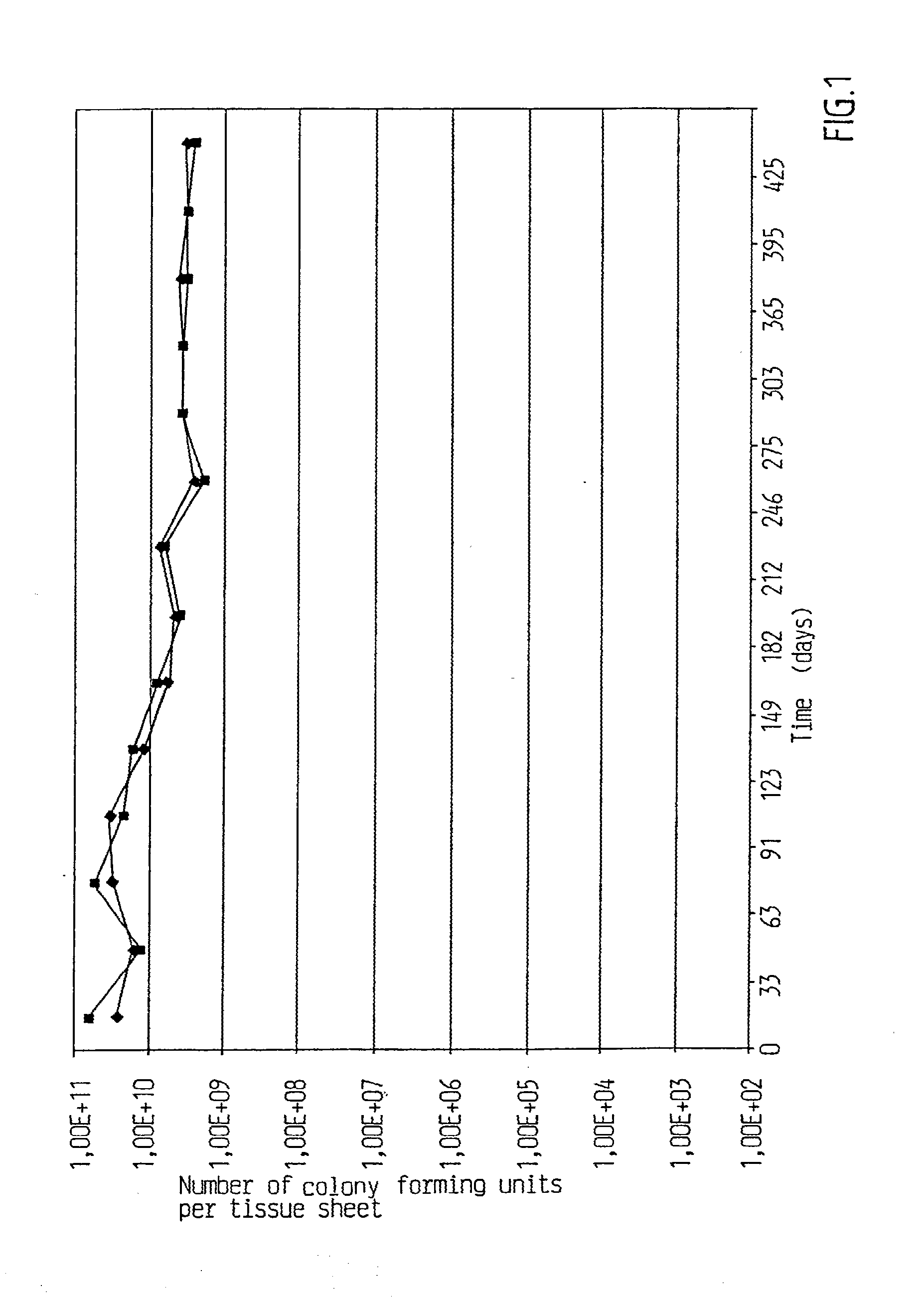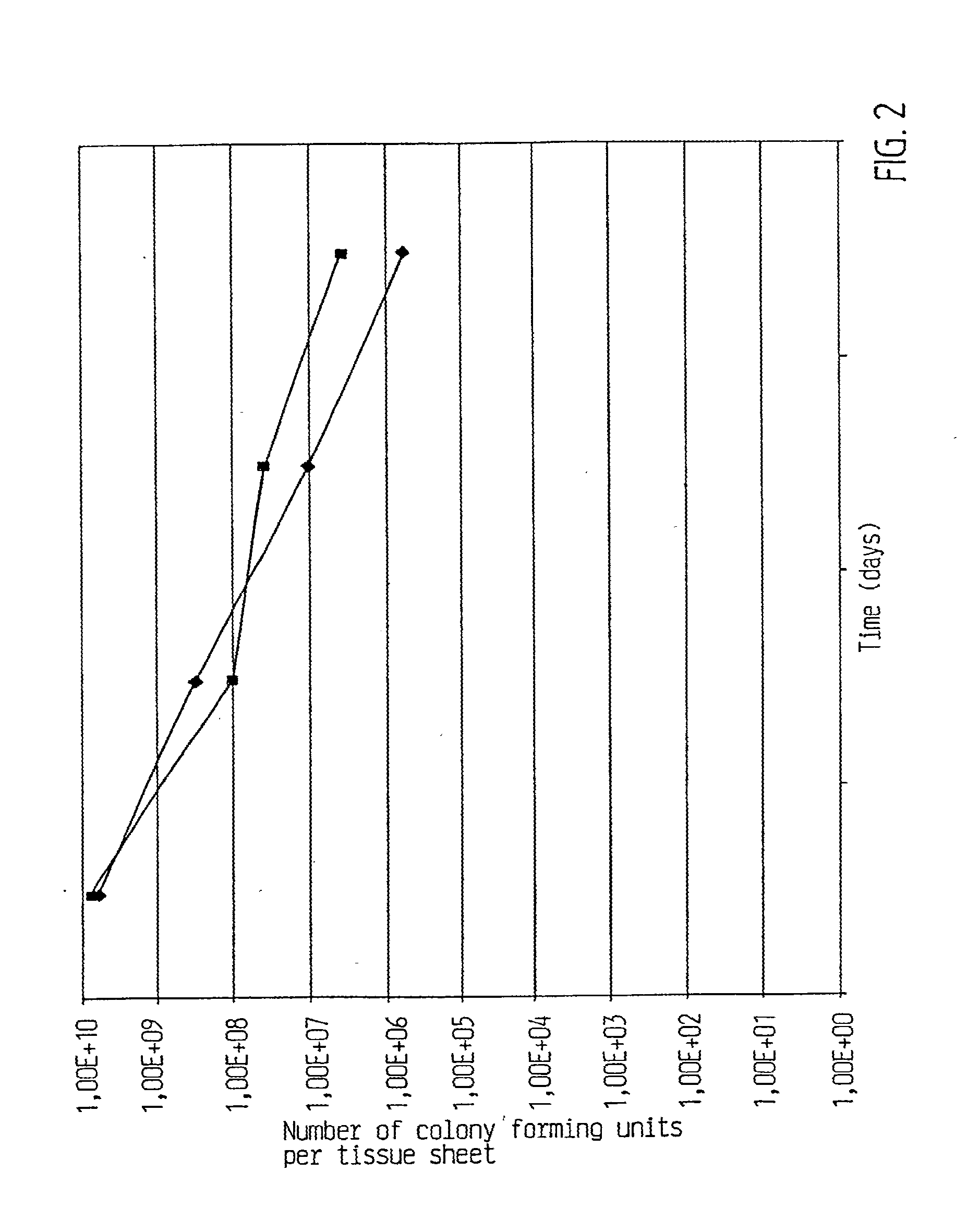Hygiene tissue
a technology of hygiene tissue and tissue, applied in the field of hygiene tissues, can solve the problems of individual prone to infection, disturbance of the normal microbial flora, and the use of antibiotics, and achieve the effects of convenient use, efficient transfer of bacteria, and loss of viability of bacterial cells
- Summary
- Abstract
- Description
- Claims
- Application Information
AI Technical Summary
Benefits of technology
Problems solved by technology
Method used
Image
Examples
example 1
Survival of Lactobacillus plantarum 931 in Olive Oil on Hygiene Tissues
[0058]A preparation of freeze dried L. plantarum 931 cells in skimmilk was ground until a powder of fine grains was formed. 10 g of the L. plantarum 931 powder was added to 120 ml olive oil (Filippo BERIO® extra virgin olive oil) and shaken until a homogenous solution was formed. An additional aliquot of 80 ml of olive oil was added and the resulting 200 ml solution was vortexed for about 2 min. The bacterial suspension was kept at room temperature for 3 hours, with mixing twice an hour. Tissue sheets (Spun Lace Dupont and SCA Absbond) were cut to 6.times.4 cm squares and placed in sterile stainless steel trays. On each tissue sheet, 2 ml of bacterial suspension was dropped over the tissue to cover it. The tissue sheet was folded in the middle, then from the long side to the middle again and packed in foil bags, which edges were welded. Samples were removed for determination of initial bacterial concentration and...
example 2
Survival of L. plantarum 931 in Lipids with Different Chemical Compositions
[0062]497 mg of a powder of L. plantarum 931 in skim milk, prepared as described in Example 1, was mixed with 5 ml of olive oil (Filippo BERIO® extra virgin olive oil, Filippo BERIO, Italy) or rapeseed oil (Felix AB, Sweden). The pH of the oils was about 5. The rapeseed oil also contained, in addition to rapeseed oil, citric acid and vitamin A and D. The suspensions were vortexed for 1 minute and allowed to rest for 1 minute. This was repeated four more times. The bacterial suspensions were kept for 4 hours at room temperature with mixing twice an hour. The suspensions were then divided into 1 ml aliquots and stored in sterile brown glass vials. The initial concentrations of bacteria in the suspensions were determined. The vials were stored in a dark place at room temperature and normal air humidity varying from 30-60%.
[0063]In addition to the experiment described above, to further compare the survival of L. ...
example 3
Study on Transfer Efficacy to and Survival Rates on Skin of L. plantarum 931 Suspended in Olive Oil, Paraffin Oil or Milli Q Water
[0066]2.00 g of freeze-dried L. plantarum 931 were added to a sterile glass vial and 40 ml of olive oil, paraffin oil or Milli Q water were added. The suspensions were shaken until homogenous solutions formed and were left at room temperature for four hours. Tissue sheets with L. plantarum 931 were prepared by cutting tissue sheets to 7.times.8 cm pieces and dropping 2 ml of the different bacterial suspensions, prepared as described above, to cover the tissue. The tissue sheets were folded in the middle, then from the long side to the middle again and packed in foil bags which edges were welded. Samples were removed for determination of initial bacterial concentrations and the remaining bags were stored at room temperature for viability studies. Two of the prepared tissue sheets with L. plantarum 931 for each preparation were used in the bend of the arm o...
PUM
 Login to View More
Login to View More Abstract
Description
Claims
Application Information
 Login to View More
Login to View More - R&D
- Intellectual Property
- Life Sciences
- Materials
- Tech Scout
- Unparalleled Data Quality
- Higher Quality Content
- 60% Fewer Hallucinations
Browse by: Latest US Patents, China's latest patents, Technical Efficacy Thesaurus, Application Domain, Technology Topic, Popular Technical Reports.
© 2025 PatSnap. All rights reserved.Legal|Privacy policy|Modern Slavery Act Transparency Statement|Sitemap|About US| Contact US: help@patsnap.com



